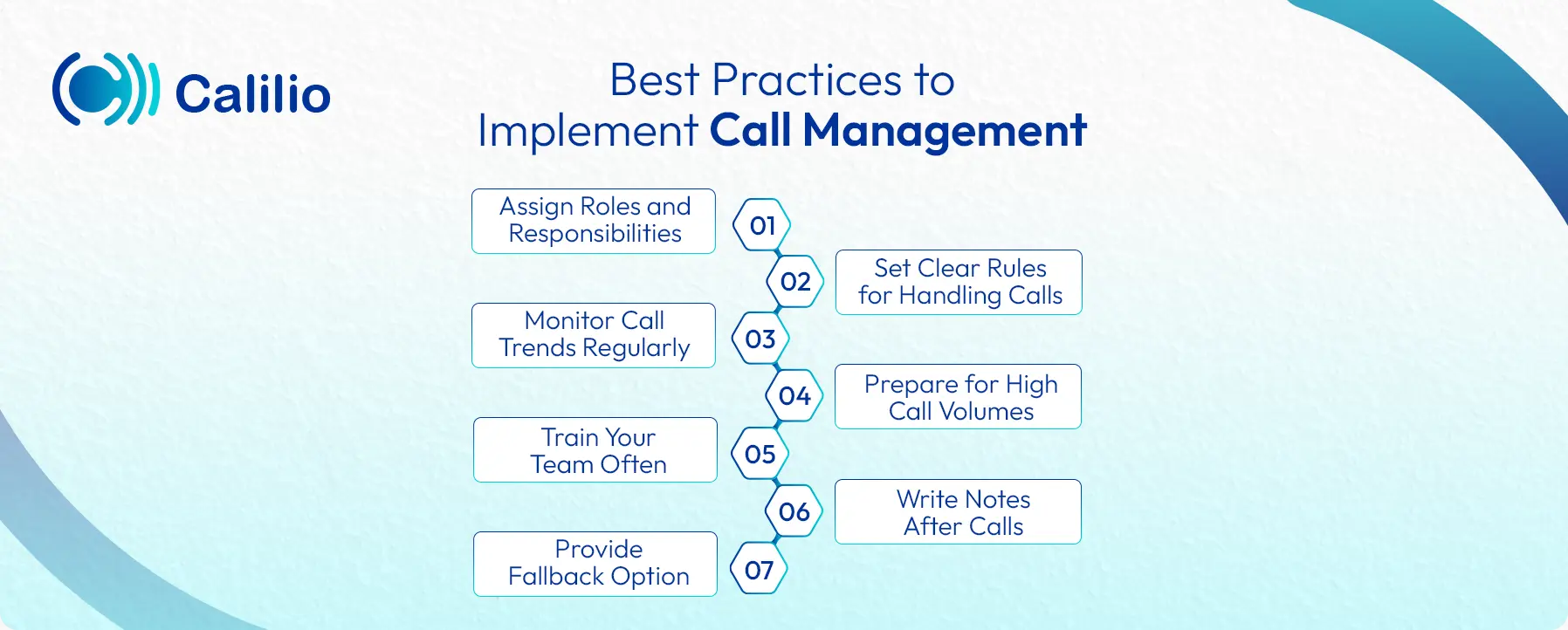What is Call Management? A Complete Guide for Businesses

Every business relies on phone communication to connect with customers, clients, and teams. But without a proper system in place, calls can be missed, customers may be left waiting too long, and important details from conversations can slip through the cracks.
Call management helps solve these issues. It organizes your call flow, automates routing, and ensures every incoming and outgoing call is tracked and answered on time. It gives your team the tools to respond faster, work smarter, and stay organized across every interaction.
In this blog, you’ll learn what call management is, its core components, why it matters, common challenges, and the best ways to manage both inbound and outbound calls in a business setting.
Key Highlights:
Call management is the process of organizing, routing, and handling inbound and outbound calls to improve communication flow.
Key features like call routing, forwarding, tracking, and recording help structure and simplify phone communication.
Businesses can manage calls manually, semi-automatically, or fully automatically depending on their size and call volume.
Call management reduces missed calls, boosts team productivity, and ensures every caller receives timely and professional support.
What is Call Management?
Call management is the process of controlling how phone calls, both inbound and outbound calls, are received, handled, organized, and directed within a business. The procedure involves how calls are answered, how long callers are placed on hold, who is responsible for handling them, and what follow-up actions are required.
It helps businesses reduce missed calls, improve average response times (AHT), and enhance the experience for both customers and teams.
Core Elements of Phone Call Management
Call management consists of key elements like call routing, queuing, forwarding, voicemail, tracking, recording, and call disposition. These features create a structured approach to phone call management to improve both internal and external communication.
- Call Routing: Automatically direct calls to the right department, team, or agent based on set rules, working hours, or caller inputs (IVR).
- Call Queuing: Places incoming callers in a queue during high traffic periods, ensuring calls are answered in order.
- Call Forwarding: Redirect calls to mobile phones or alternative agents when the primary receiver is unavailable.
- Voicemail & Callback Options: Let callers leave messages or request a callback if no one is available, reducing lost opportunities.
- Call Tracking & Logging: Records time, duration, status, and context of every call for performance monitoring and reporting.
- Call Recording: Keeps audio records for quality assurance, training, and dispute resolution.
- Call Disposition & Notes: Mark the outcome of each call with clear labels like “Interested,” “Follow-up Needed,” or “Resolved.”
Different Approaches to Handle Calls
Call management typically uses three main approaches to handle calls: manual, semi-automated, and fully automated. The right approach depends on your business size and call volumes.

1. Manual Call Management
In this method, a person, often a receptionist, handles all the inbound and outbound calls. During the process, they speak to the caller, understand their need, solve the customer's issues, or transfer the call to the right person or department if required.
This method works well for small businesses with low call volume. It feels personal and direct. But it may become inefficient for a business with high call volume.
2. Semi-Automated Call Management
This approach uses both people and basic technology to manage calls more efficiently. When someone calls, they are first greeted by an Interactive Voice Response (IVR) system. The caller chooses from simple menu options (e.g., “Press 1 for Sales, Press 2 for Support”), and then the system routes the call to the live agent.
This method works well for businesses with moderate call volumes. It improves efficiency without requiring a large contact center setup.
3. Fully Automated Call Management
This is a technology-driven method used by larger businesses or contact centers. It uses systems like Automatic Call Distribution (ACD) for inbound call management and auto-dialers to make outbound calls. Plus, it can also be integrated with CRM tools.
It also uses advanced features like real-time analytics and an intelligent virtual agent to handle customer requests automatically. This is the most scalable and efficient approach for managing large volumes of calls.
Why Do Businesses Need Call Management?
Businesses need phone call management to ensure every call is answered, routed, or followed up properly, preventing missed opportunities. It also improves customer experience, boosts team efficiency, and supports smooth growth with consistent and professional communication.
I. Prevent Missed Calls
A reliable call management process ensures that every call is either answered, forwarded, or sent to voicemail. This keeps your business reachable anytime, whether it’s during peak hours or after business hours, helping you avoid losing potential leads or clients.
II. Improve Customer Experience
When customers reach the right person without long wait times or repeated transfers, they feel heard and respected. With proper call handling, you reduce frustration and build trust during every phone interaction.
III. Enhance Team Efficiency
Call management automates routine tasks like transferring calls or answering common questions. It helps your team save time and stay focused on more important work. Also, by sending each call to the right person, it keeps operations smooth and efficient.
IV. Ensure Consistency and Accountability
With every call tracked, documented, and labeled, businesses gain full visibility on call activity. You can check call status, review conversations, and ensure that follow-ups are completed. This helps maintain high service standards.
V. Scale Operations Easily
A structured call management approach lets you add new team members, departments, or locations without disrupting communication. It keeps your system efficient, no matter how fast you scale.
VI. Increase Sales and Lead Conversions
A well-managed outbound call management process helps sales teams follow up faster, prioritize leads, and avoid duplicate outreach. By using tools like call tagging and notes, they stay on top of every opportunity.
VII. Create a Professional Impression
The way your business handles phone calls leaves a lasting impression. When callers are greeted politely, connected to the right person quickly, and guided through a smooth call experience, it signals professionalism and reliability.
What are the Common Challenges in Phone Call Management?
Businesses often face challenges like overloaded phone lines, staff burnout, disconnected tools, and rising operational costs during business call handling. These problems affect customer satisfaction, team performance, and overall efficiency.
1. High Call Volume and Long Wait Times
When too many calls come in at once, customers wait longer or hang up before getting help. This leads to a high number of abandoned calls and repeated attempts, putting even more pressure on your team.
2. Agent Burnout
Handling a high volume of calls daily can exhaust your team. Without proper training, tools, or support systems, they may struggle to solve issues on the first call. Over time, this affects morale, reduces service quality, and increases staff turnover.
3. Technology and Integration Issues
Disconnected systems slow agents down. When platforms don’t work together, it becomes difficult to access customer information or switch between communication channels. As a result, calls take longer and customers receive inconsistent service across phone, chat, or email.
4. Balancing Operations and Costs
Hiring more staff can reduce wait times, but it increases costs. Hiring too few agents lowers costs but creates service delays. It’s a constant challenge to schedule the right number of agents, invest in tools, and maintain call quality, all while keeping costs under control.
Best Practices to Implement Call Management
To implement effective call management, define how calls are routed, ensure each team knows their role, and prepare for peak hours. Additionally, monitor call trends and provide a fallback option like voicemail or call forwarding when agents are unavailable.

- Assign Roles and Responsibilities: Make sure every call has a clear owner. Whether it’s support, sales, or billing, teams should know which types of calls they handle.
- Set Clear Rules for Handling Calls: Decide how different calls should be answered, routed, or forwarded. This avoids confusion and keeps your process consistent.
- Monitor Call Trends Regularly: Keep track of call patterns such as volume, duration, and frequent topics. This helps you spot common issues and improve your phone call handling process.
- Prepare for High Call Volumes: Plan for busy times by reviewing past call trends. If you expect more calls during certain days, prepare in advance by adjusting team availability.
- Train Your Team Often: Give regular training to improve listening, speaking, and problem-solving. Even experienced agents can benefit from practice and feedback.
- Write Notes After Calls: After each call, note what happened and what needs to be done next. This helps your team remember details and keeps follow-ups on track.
- Provide Fallback Option: Have a backup ready when no one is available to take a call. Use voicemail, call forwarding, or set up a callback.
How To Choose the Right Call Management Solution for Your Business?
Before implementing a phone management system, first define your business goals and understand your call volume, types, and team capacity. Then, choose a solution that fits your budget, aligns with your workflow, and supports the caller experience you want to deliver.
Set Clear Business Goal
Define your business goal; whether it’s reducing missed calls, improving first-call resolution, or shortening response times. Clear goals help you measure the success of your phone call management efforts and prioritize the right tools.
Evaluate Your Call Volume and Call Types
Start by analyzing how many calls your team handles each day. Separate inbound calls (support, inquiries) from outbound calls (sales, follow-ups). This helps you choose features that match your needs.
Assess Your Team Size and Technical Capability
Evaluate how many team members will use the system and how comfortable they are with using new technology. Smaller teams with limited tech expertise may benefit from a simpler setup, while larger teams can handle more advanced tools and configurations.
Consider Your Budget
Consider how much your business can invest in a call management solution. Your budget will influence whether you adopt a basic setup or a more advanced system with automation and integration features.
Define the Calling Experience You Want to Provide
Decide what kind of experience you want to deliver to your callers. If you aim for fast, automated routing, features like IVR or ACD are essential. For a more personal touch, a blend of automation and human support may work better.
Conclusion
Call management is essential for any business that relies on phone communication. It helps organize calls, reduce missed opportunities, and keep your team productive. By choosing the right tools, setting clear rules, and preparing your team, you can manage calls more effectively and create a better experience for both your staff and your customers.

Get Cashbacks Up to 43% Straight To Your Wallet!
Unlimited Virtual Numbers – Local, Mobile & Toll-Free from 100+ Countries
Free Local Phone Number from US or Canada
Crystal-Clear Calls Starting at Just $0.0153/min
24/7 Human Support – Because Great Service Never Takes a Holiday


Frequently Asked Questions
How does call management differ in traditional call centers vs. modern contact centers?
Traditional call centers focus mainly on handling voice calls, while modern contact centers manage multiple channels like phone, chat, email, and social media using integrated call management tools.
How does call management differ from call handling?

Still have questions?
Can’t find the answer you’re looking for? Please chat with our friendly team.
Stay in the loop
Get the latest call insights, trends, and updates delivered straight to your inbox.
By subscribing, you agree to receive updates from Calilio.
You can unsubscribe anytime.